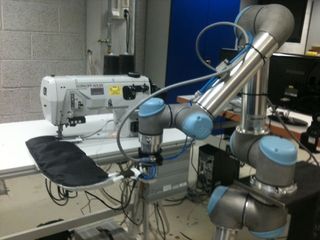Pentagon's Robot Sewing Machines Take Aim at China's Factories

Americans may never again buy clothes labeled "made in China" if robot sewing machines can beat Chinese costs of labor. The Pentagon has given $1.2 million to a Georgia Tech spinoff company to turn that futuristic concept into reality.
Such computer-controlled sewing machines must precisely move fabric under the needle "stitch by stitch" and carefully track passing threads — a job normally done with human hands and eyesight. Success could lead to automated U.S. factories that "produce garments with zero direct labor," according to the contract issued by the U.S. Defense Advanced Research Projects Agency (DARPA) on June 5.
The idea of making garment cutting and sewing a profitable U.S. business came from Steve Dickerson, founder and chief technology officer of Softwear Automation (the Georgia Tech spinoff company that received DARPA's recent $1.2 million funding). [6 Tips for Inventors From a DARPA Program Manager]
Dickerson realized the possibility for robotic sewing machines after observing that sewn items had disappeared almost entirely from his hometown of Commerce, Ga., and most of the United States. The U.S. currently imports about $100 billion worth of clothes and sewn items each year — much of it from countries such as China or Vietnam.
"The [robotic] technology proposed appears to allow cutting and sewing at costs LESS THAN in China," according to Softwear Automation's website. "There is only one basic innovation required; that the metric of motion should not be meters or inches but rather thread count in the fill and warp directions."
Success could spell out huge disruptions for workers as robots continue taking over human jobs in manufacturing and other industries. Low-paid workers in developing countries stand to lose out the most in this case, but U.S. workers won't gain much, either. Still, U.S. businesses could once again regain a foothold in the garment industry and win back a share of international trade.
The robotic revolution won't stop there. Dickerson has also suggested robots could return manufacturing of smartphones, computers and TVs to U.S. shores — an idea expressed in an email to the National Institute of Standards and Technology in 2011. A robotic uprising there could turn up the heat for companies such as Foxconn that manufacture Apple's iPhones and iPads.
Sign up for the Live Science daily newsletter now
Get the world’s most fascinating discoveries delivered straight to your inbox.
This story was provided by InnovationNewsDaily, a sister site to LiveScience. You can follow InnovationNewsDaily on Twitter @News_Innovation, or on Facebook.
Most Popular


